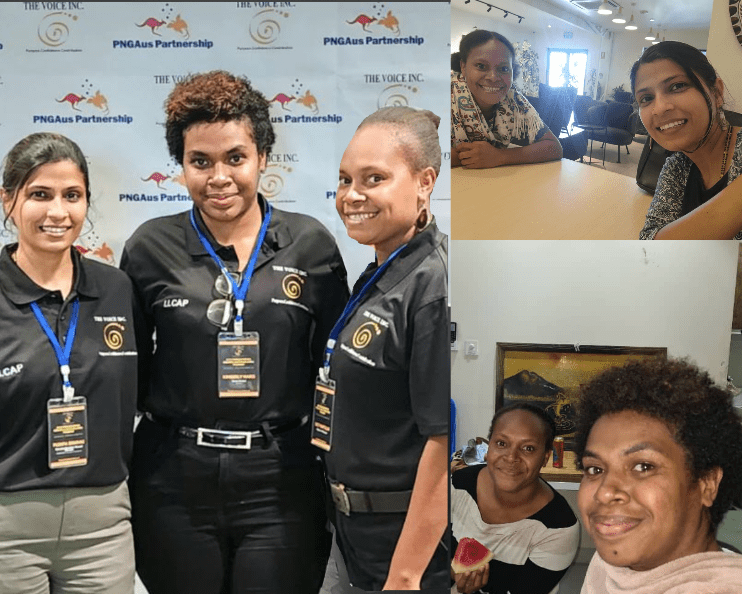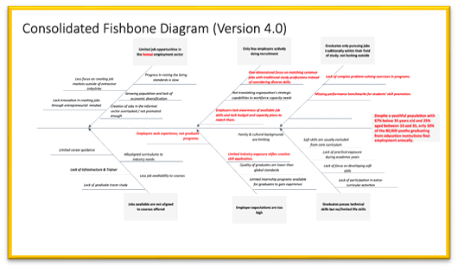Guest blog written by Lucy Napitalai, Kimberly Naris, Pushpa Srinivas
As we embark on the final reflections of this 12-week course, the echoes of wisdom and insights gained resonate in the corridors of our experience. This journey has been more than an academic exploration; a dynamic and immersive expedition woven with challenges, revelations, and a commitment to address youth unemployment that tugs at the very fabric of our society. Holistically, the key learnings of this transformative journey include:
The Power of Collective Action: The resounding theme that reverberated in our discussions, readings, and interactions was the power embedded in collective action. The understanding is that, when individuals unite with a shared purpose, pooling diverse skills and perspectives, they unlock a reservoir of potential that can address even the most complex and entrenched challenges.
Soft Skills as Catalysts: Our focus on soft skills proved to be a powerful catalyst for change. We delved into the understanding that beyond the realm of technical knowledge, the ability to communicate effectively, collaborate seamlessly, and lead with empathy is the glue that binds successful collective action. These interpersonal skills emerged as the linchpin in mobilizing and sustaining efforts towards a common goal.
Adaptive Problem-Solving: Embracing the iterative nature of the process, we learned not to shy away from uncertainties but to dance with them. We experimented with solutions, learned from setbacks, and understood that adaptation is not a sign of failure but a testament to the resilience required for meaningful change.
Importance of Trust: The spotlight also shone on the profound significance of trust in the delicate fabric of working with others. Building and maintaining trust is foundational for effective collaboration. It creates an environment where ideas can flourish, and a shared vision can be cultivated which are vital elements in the journey towards meaningful and sustained action.

The Problem at the Heart of Our Efforts: Our collective focus has been on unravelling the multifaceted challenge of youth unemployment in PNG. Despite boasting a youthful population with 67% below 35 years old and 25% aged between 16 and 35, a staggering revelation came to light – only 10% of the 80,000 youths graduating from educational institutions find employment annually. This revelation became the crucible upon which we applied the principles gleaned from our learning. Our initiatives spanned from engaging with local stakeholders, forging alliances with educational institutions, and crafting transitional training programs aimed at equipping graduates with the necessary tools for professional success.
In our group photo, what meets the eye is not merely a collection of smiling faces but a tableau that encapsulates a team, a unit committed to steering the needle of change. Each member, with a unique perspective and a distinct set of skills, contributed through ideas, time and effort. It is a visual testament to the diversity of thoughts, the synergy of skills, and the shared commitment to a cause larger than us. It encompasses the journey of our bonds turning from acquaintances to be part of the broader PDIA family, learning from each other, and collectively navigating the unknowns and knowns of leadership and collective action.

Pivoting to the youth unemployment faced here in PNG, we’ve realized through the course that we must continue to be flexible to the possibilities of changing any preconceived ideologies on this issue as well as our approach to address the issue. Reflecting on the early assignments of the course, our initial perspectives on youth unemployment was very ambiguous and based on a lot of anecdotal evidence. Our journey of focusing on the problem took an interesting turn when we clearly defined our problem statement as underlined above and identified causes and sub-causes using the fishbone diagram. After four iterations of the different aspects of the problem statement, we have reached a refined version of the fish bone diagram at the end of the course as below:
It addresses three main aspects: graduates (employees), the employment sector, and employers. From the graduate’s perspective, we outlined their needs by examining the causes of certain deficiencies, such as lacking soft skills, industry exposure, practical experience, and more. In the employment sector, we identified the limited availability of jobs, lack of alignment of jobs or industry needs to the curriculum, and lack of innovation in creating jobs and the entrepreneurial mindset.
Those causes were analysed further using the Triple-A space analysis, which objectively directed our actions. We have progressed the analysis to gauging perspectives from our engagement with respective sources of knowledge, as well as our collective ideas to refine our actions. This journey taught us specifically problem-solving approaches including, clearly articulating the issue with sufficient evidence, identifying all stakeholders impacted, tracing causes and sub-causes of the issue, and then using the Triple-A analysis tool to assess our ability, the acceptance, and required authorization for the actions to undertake.
Ultimately, we have gained a profound understanding of the methodology, which has equipped us with invaluable tools and insights that we intend to continue practice to address the youth unemployment issue and beyond. As we graduate the course, this is a beginning of a new chapter, that we must navigate through possible solutions and address youth unemployment piece by piece.
PDIA course offered a structured and practical approach to solving complex problems. By breaking down issues into smaller, manageable components and continuously iterating through potential solutions, we have learned how to approach any challenge with a more systematic mindset which will be of immense value to apply in our professional backgrounds.
In parallel, the course has demonstrated the importance of a people-centric approach. By emphasizing the involvement of a diverse group of stakeholders and their ideas in the problem-solving process, it ensures that the solutions generated are contextually relevant and sustainable. In future work, we plan to incorporate this approach by encouraging cross-functional collaboration and actively seeking input from those affected by the problem. This will lead to more inclusive and effective problem-solving.
PDIA’s emphasis on experimentation and learning from failures is another concept that we plan to integrate into our professional backgrounds. It has demonstrated that learning often occurs most significantly through failure. We will use this insight to foster a culture of experimentation and learning, where mistakes are viewed as opportunities for growth rather than failures.
Moreover, the course has underscored the significance of perseverance and adaptability. In the face of complex problems, it is common to feel discouraged or overwhelmed. However, PDIA taught us the value of pushing forward and adapting our strategies as we learn from each iteration. This resilience will serve us well beyond the professional realm to also personal endeavours. We have learned that even the most daunting challenges can be overcome with patience and a willingness to evolve.
As we reflect on our PDIA journey, there are some words of wisdom to share with fellow PDIA practitioners around the world.
Firstly, embrace ambiguity and uncertainty. Complex problems rarely come with easy solutions, and it’s important to accept the uncertainty that accompanies them. Rather than feeling overwhelmed by the unknown, view it as an opportunity for creativity and innovation.
Secondly, maintain a learner’s mindset. PDIA is rooted in the belief that we can always learn and adapt. Be open to new ideas, feedback, and different perspectives. This will not only help you improve your problem-solving skills but also foster a collaborative and inclusive environment.
Lastly, stay committed to your purpose. PDIA is not a quick-fix approach; it requires dedication and persistence. It’s easy to become disheartened when faced with setbacks but remember that every iteration is a step forward. Stay true to your goals and the positive impact you aim to make.
In conclusion, the lens through which we viewed the issue of youth unemployment, coupled with the insights gained from our course, has now become the prism through which we approach problem-solving and leadership. The journey doesn’t conclude here; instead, it becomes a stepping stone towards a future where empowered leaders drive meaningful collective action. As we continue this odyssey beyond the confines of the course, the lessons learned, the challenges surmounted, and the bonds forged will remain indelibly etched in our approach to leadership and impact. In Professor Matt’s voice: ‘Small is beautiful!’ This is what we will move out with – addressing youth unemployment is an ongoing narrative, a saga of unlocking leadership potential, and a commitment to creating lasting ripples of change that will support and benefit the now and future youth demography of PNG.
This blog was written by participants who completed a 12-week PDIA for PNG online action-learning program from August – December 2023. 36 participants successfully completed this program.
